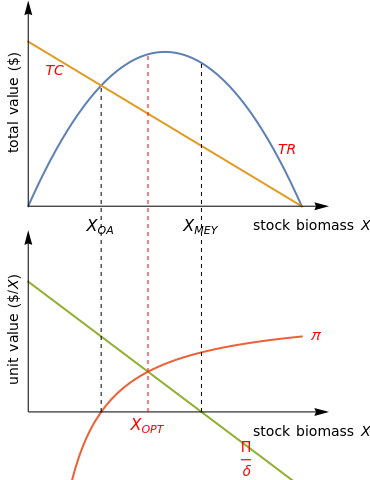Maximizing the Present Value of Resource Rent in a Gordon-Schaefer Model
Maximizing the Present Value of Resource Rent in a Gordon-Schaefer Model
The classical Gordon–Schaefer model presents equilibrium revenue () and cost (, including opportunity costs of labor and capital, in a fishery where the fish population growth follows a logistic function. Unit price of harvest and unit cost of fishing effort are assumed to be constants. In this case, the open access solution without restrictions () is found when and no rent (abnormal profit, ) is obtained. Abnormal profit (here resource rent) is maximized when (maximum economic yield, ). Discounted future flow of equilibrium rent is maximized when , where is the unit rent of harvest and is the discount rate. This situation is referred to as the optimal solution (), maximizing the present value of all future resource rent. The open access solution and equilibriums are found to be special cases of the optimal solution, when and , respectively.
TR
TC)
OA
TR=TC
Π=TR-TC
TR'(X)=TC'(X)
MEY
Π'(X)/δ=π
π
δ
OPT
MEY
δ=∞
δ=0
Details
Details
The basic Gordon–Schaefer model includes the following:
Surplus growth of the fish stock population (logistic growth):
f(X)=rX(1-X/K)
X
r
K
Assume that the fish harvest () is linear in stock biomass () and fishing effort ():
H
X
E
H=qEX
q
The equilibrium catch is found at the stock biomass value where , , or .
X
H=f(X)
X=0
X=K(1-qE/r)
Assume further a constant unit price of harvest, , and a constant unit cost of effort, . Total revenue () is then
p
c
TR
TR=pH
and total cost () is
TC
TC=cE
Assume includes all opportunity costs, reflecting the normal profit in perfect markets. Abnormal profit (rent) is then
c
Π=TR-TC
which in equilibrium () could be written as a function of as
H=f(X)
X
Π(X)=(p-cX/q)f(X)
Denote the unit rent of harvest by ; then
π
π(X)=p-cX/q
The optimal equilibrium solution (maximizing the present value of future harvests in equilibrium) is obtained when the short-term loss of not fishing one unit more () equals the long-term discounted benefit related to this unit being included in the future stock (). See Clark (1976) for further details.
π(X)
Π'(X)/δ
C. W. Clark, Mathematical Bioeconomics: The Optimal Management of Renewable Resources, New York: Wiley–Interscience, 1976.
Permanent Citation
Permanent Citation
